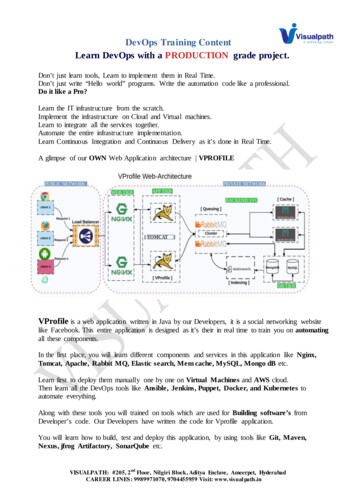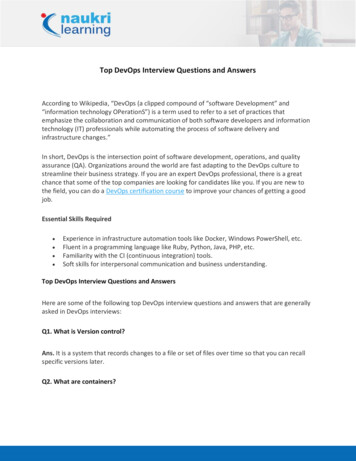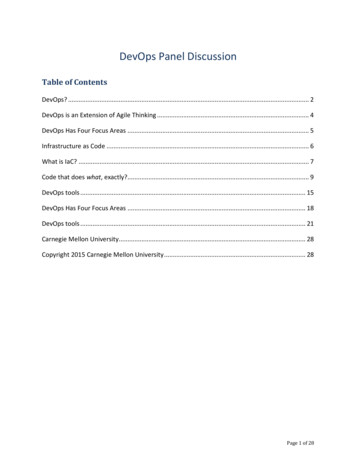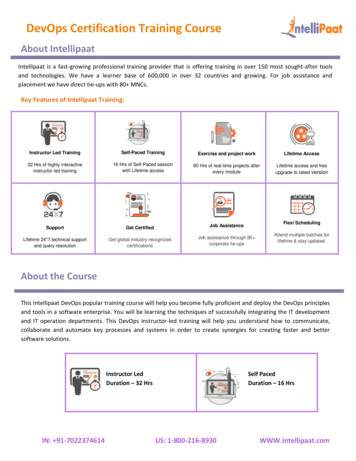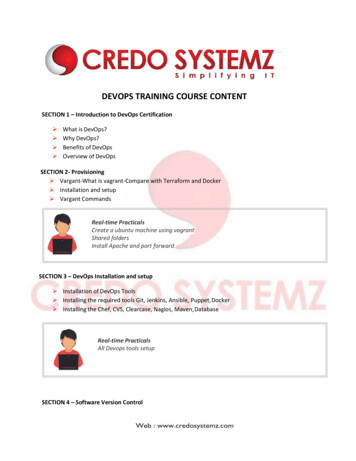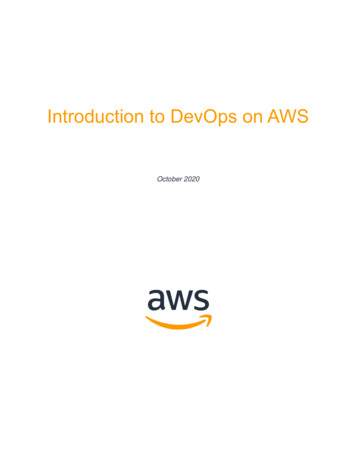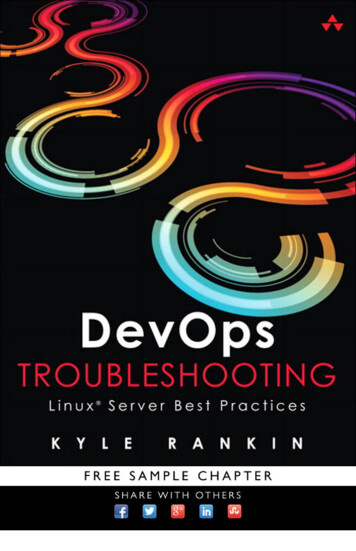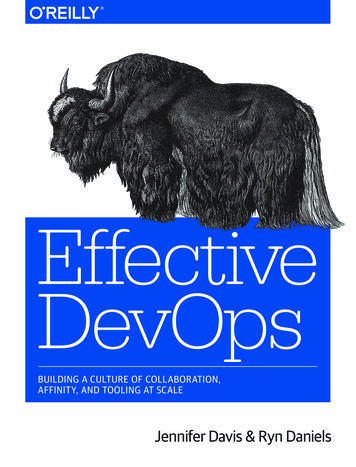
Transcription
Bring yourDevOps toAzureTake a simple path to developing andoperating your apps in the cloud.With your Azure free account, you get: 12 months of popular free services A 200 credit to explore any Azure servicefor 30 days More than 25 always-free servicesUse Azure to: Practice cloud-based CI/CD Get full-stack monitoring Use the toolchain of your choiceLearn more
Praise for Effective DevOps“Excellent reading for anyone interested in understandingdevops and how to foster a devops culture.”—James Turnbull, CTO at Kickstarter“Devops is not another “tech movement” that can be deferred and discarded;it has tentacles throughout the organization from concept to cash. Anyone who haswatched their cost of building new features increase, or has lived through thefrustrations of unplanned downtime, will understand the intrinsic valuesespoused by the devops movement."Effective DevOps is the most comprehensive book I’ve seen on the topic; and one that iscompletely digestible and applicable for those within technology and the lines of business.I particularly enjoyed the sections debunking common myths and memes regardingdevops; such as it being cost prohibitive, only applicable to startups, or that it’s a positionto be filled. Such resounding rebuttals help preserve the spirit of devops and keepscommoditization of the movement at bay. This book will become recommendedreading for any organization that conceives, develops, and deploys software.”—Nivia S. Henry, Sr. Agile Coach at Summa“High performance organizations see technology as a strategic capability. However, theyunderstand that technology is often not the most challenging dimension. Culture matters.How well your organization collaborates, experiments and seeks to learn and shareknowledge dictates the level it not only accepts but will achieve. In this book, Jennifer andRyn have outlined the necessary conditions to create a system of work for your businessto develop its own path towards continuous improvement, growth and transformation.Read it, reflect on it, then deploy it.”—Barry O’Reilly, Founder and CEO, ExecCamp and coauthor ofLean Enterprise: How High Performance Organizations Innovate At Scale (O’Reilly)
“Careful attention to the history and traditions of the devops movementmeets detailed advice and empathy for today’s practitioners.”—Bridget Kromhout, Principal Technologist at Pivotal"Effective DevOps is a flat-out impressive collection of the bits and pieces that make upwhat is essentially the largest shift in technical work since the Agile Manifesto waspublished. It brings together stories and resources from diverse resources that feel worldsapart and presents everything in an approachable manner, and covers not just tools butthe culture, behavior, and work pattern characteristics that are soessential for successful technology teams.”—Mandi Walls, Technical Community Manager at Chefand author of Building a DevOps Culture (O’Reilly)“Everyone knows culture is important in the context of devops, but we’ve lacked abook-length reference into this vital topic. Effective DevOps is a broad, deep inquiryinto human factors that should be studied by every manager who wants tobuild high performing technical teams and organizations.”—Jez Humble, coauthor ofContinuous Delivery (Addison-Wesley) and Lean Enterprise (O’Reilly)
Effective DevOpsBuilding a Culture of Collaboration,Affinity, and Tooling at ScaleJennifer Davis and Ryn DanielsBeijingBoston Farnham SebastopolTokyo
Effective DevOpsby Jennifer Davis and Ryn DanielsCopyright 2016 Jennifer Davis and Ryn Daniels. All rights reserved.Printed in the United States of America.Published by O’Reilly Media, Inc., 1005 Gravenstein Highway North, Sebastopol, CA 95472.O’Reilly books may be purchased for educational, business, or sales promotional use. Online editions arealso available for most titles (http://oreilly.com/safari). For more information, contact our corporate/insti‐tutional sales department: 800-998-9938 or corporate@oreilly.com.Editor: Brian AndersonProduction Editor: Colleen LobnerCopyeditor: Rachel MonaghanProofreader: Jasmine KwitynIndexer: WordCo Indexing ServicesInterior Designer: David FutatoCover Designer: Randy ComerIllustrator: Rebecca DemarestFirst EditionJune 2016:Revision History for the First Edition2016-05-23:2018-01-19:2018-04-06:First ReleaseSecond ReleaseThird ReleaseSee http://oreilly.com/catalog/errata.csp?isbn 9781491926307 for release details.The O’Reilly logo is a registered trademark of O’Reilly Media, Inc. Effective DevOps, the cover image of awild yak, and related trade dress are trademarks of O’Reilly Media, Inc.While the publisher and the authors have used good faith efforts to ensure that the information andinstructions contained in this work are accurate, the publisher and the authors disclaim all responsibilityfor errors or omissions, including without limitation responsibility for damages resulting from the use ofor reliance on this work. Use of the information and instructions contained in this work is at your ownrisk. If any code samples or other technology this work contains or describes is subject to open sourcelicenses or the intellectual property rights of others, it is your responsibility to ensure that your usethereof complies with such licenses and/or rights.This work is part of a collaboration between O’Reilly and Microsoft. See our statement of editorial inde‐pendence.978-1-492-07309-3[LSI]
Table of ContentsForeword by John Allspaw. . . . . . . . . . . . . . . . . . . . . . . . . . . . . . . . . . . . . . . . . . . . . . . . . . . . . . xvForeword by Nicole Forsgren. . . . . . . . . . . . . . . . . . . . . . . . . . . . . . . . . . . . . . . . . . . . . . . . . . . xviiPreface. . . . . . . . . . . . . . . . . . . . . . . . . . . . . . . . . . . . . . . . . . . . . . . . . . . . . . . . . . . . . . . . . . . . . . xixPart I.What Is Devops?1. The Big Picture. . . . . . . . . . . . . . . . . . . . . . . . . . . . . . . . . . . . . . . . . . . . . . . . . . . . . . . . . . . . . 3A Snapshot of Devops CultureThe Evolution of CultureThe Value of the StoryRyn’s StoryJennifer’s StoryIllustrating Devops with Stories35789112. What Is Devops?. . . . . . . . . . . . . . . . . . . . . . . . . . . . . . . . . . . . . . . . . . . . . . . . . . . . . . . . . . . 13A Prescription for CultureThe Devops EquationDevops as Folk ModelThe Old View and the New ViewThe Devops Compact13131414153. A History of Devops. . . . . . . . . . . . . . . . . . . . . . . . . . . . . . . . . . . . . . . . . . . . . . . . . . . . . . . . 19Developer as OperatorThe Advent of Software EngineeringThe Advent of Proprietary Software and Standardization192021v
The Age of the NetworkThe Beginnings of a Global CommunityThe Age of Applications and the WebThe Growth of Software Development MethodologiesOpen Source Software, Proprietary ServicesAgile InfrastructureThe Beginning of devopsdaysThe Current State of DevopsSummary2223242526272829294. Foundational Terminology and Concepts. . . . . . . . . . . . . . . . . . . . . . . . . . . . . . . . . . . . . 31Software Development MethodologiesWaterfallAgileScrumOperations MethodologiesITILCOBITSystems MethodologiesLeanDevelopment, Release, and Deployment ConceptsVersion ControlTest-Driven DevelopmentApplication DeploymentContinuous IntegrationContinuous DeliveryContinuous DeploymentMinimum Viable ProductInfrastructure ConceptsConfiguration ManagementCloud ComputingInfrastructure AutomationArtifact ManagementContainersCultural zational LearningSummaryvi Table of 4142424243434444
5. Devops Misconceptions and Anti-Patterns. . . . . . . . . . . . . . . . . . . . . . . . . . . . . . . . . . . . 45Common Devops MisconceptionsDevops Only Involves Developers and System AdministratorsDevops Is a TeamDevops Is a Job TitleDevops Is Relevant Only to Web StartupsYou Need a Devops CertificationDevops Means Doing All the Work with Half the PeopleThere Is One “Right Way” (or “Wrong Way”) to Do DevopsIt Will Take X Weeks/Months to Implement DevopsDevops Is All About the ToolsDevops Is About AutomationDevops Is a FadDevops Anti-PatternsBlame CultureSilosRoot Cause AnalysisHuman ErrorSummary4545464647484849495050525353545455556. The Four Pillars of Effective Devops. . . . . . . . . . . . . . . . . . . . . . . . . . . . . . . . . . . . . . . . . . 57CollaborationAffinityToolsScalingSummaryPart II.5858585859Collaboration7. Collaboration: Individuals Working Together. . . . . . . . . . . . . . . . . . . . . . . . . . . . . . . . . . 63Sparkle Corp Weekly Planning MeetingDefining CollaborationIndividual Differences and BackgroundsProfessional BackgroundsPersonal BackgroundsGoalsCognitive StylesOpportunities for Competitive AdvantageMentorshipSenior-to-Junior MentoringSenior-to-Senior Mentoring6364656567686971727272Table of Contents vii
Junior-to-Senior MentoringJunior-to-Junior MentoringIntroducing MindsetsCultivating the Right MindsetFixed MindsetGrowth MindsetFocus on Individual GrowthMindsets and Learning OrganizationsThe Role of FeedbackReviews and RankingsFrequency of FeedbackRanking SystemThe Problems with Rock Stars and SuperflocksThe Value of Social Capital to a TeamCommunication and Conflict Resolution StylesEffective CommunicationHow We CommunicateCommunication Context and Power DifferentialsEmpathy and TrustDeveloping EmpathyDeveloping TrustHumane Staffing and ResourcesAvailability and MaintenanceWork–Life BalanceTeam Size ConsiderationsEffective Collaboration with Sparkle 2949696979798998. Collaboration: Misconceptions and Troubleshooting. . . . . . . . . . . . . . . . . . . . . . . . . . . 101Collaboration MisconceptionsYou Can’t Teach an Old Sysadmin New TricksYou Need to Hire Rock Stars When You’re Trying to Grow QuicklyA Diverse Team Can’t Collaborate as EffectivelyCollaboration TroubleshootingSome People on the Team Aren’t Pulling Their WeightWe Need to Decide If We Should Let Someone GoI’m Overworked, Stressed, and Burnt OutSome People on the Team Are Feeling DisrespectedSome People Aren’t Communicating EnoughAn Employee (or Candidate) Is Technically Brilliant, but Also a JerkI Don’t Feel Like My Career Is Progressing Within My CurrentTeam/Organizationviii Table of Contents101101102103103103105106107108109110
Nobody Listens to Me (Anymore)We Just Had a Reorganization or Staff ReductionPart III.111112Affinity9. Affinity: From Individuals to Teams. . . . . . . . . . . . . . . . . . . . . . . . . . . . . . . . . . . . . . . . . 117Sparkle Corp Development Demo DayPeople NetworksWhat Makes a Team?The Work That Teams DoDefining AffinityInterpersonal Ties Within TeamsTeam CultureTeam CohesionDiversityBenefits of DiversityAxes of Diversity and IntersectionalityHiring ConsiderationsMaintaining an Inclusive EnvironmentTeams and Organizational StructureFinding Common Ground Between TeamsFrom Competition to CooperationBuilding Team EmpathyImproving Team CommunicationCase Study: United States Patent and Trademark OfficeBackground and DirectionsEncouraging Collaboration and AffinityBalancing Multiple ViewpointsBenefits of Improved AffinityShortened Cycle TimeReduction of Communication BarriersTrustInnovationRequirements for AffinitySlackExplicit Values and GoalsSpaceCollaboration and CooperationMeasuring AffinityEmployee Skills and EvaluationsInterteam 5156157158158159Table of Contents ix
Giving Back to the CommunitySparkle Corp Dev and Ops AffinitySummary16016116110. Affinity: Misconceptions and Troubleshooting. . . . . . . . . . . . . . . . . . . . . . . . . . . . . . . . 163Affinity MisconceptionsOps Engineers Aren’t as Valuable to the Organization as Developers AreSharing Too Much Outside the Company Might Weaken Our CompetitivePositionAffinity TroubleshootingOne or More Individuals Are Interrupting Group Flow DynamicsOne Team Keeps Blocking Other TeamsSome Teams Are Feeling UndervaluedPeople Don’t Seem to Trust Each OtherPeople Are Concerned Solely About Technical Aspects of Work, NotInterpersonal OnesDifferent Teams Seem Like They Won’t Ever Be Able to ReallyWork TogetherPast Interpersonal Conflicts Are Causing Present Interteam ConflictsTeam X Seems to Want to Be Their Own SiloPeople Are Blaming Mistakes on DevopsPart IV.163163164165165166167168169170171172173Tools11. Tools: Ecosystem Overview. . . . . . . . . . . . . . . . . . . . . . . . . . . . . . . . . . . . . . . . . . . . . . . . 177Software DevelopmentLocal Development EnvironmentVersion ControlArtifact ManagementAutomationServer InstallationInfrastructure AutomationSystem ProvisioningTest and Build olution of the EcosystemSummaryx Table of 191192
12. Tools: Accelerators of Culture. . . . . . . . . . . . . . . . . . . . . . . . . . . . . . . . . . . . . . . . . . . . . . 193The Value of Tools to PeopleWhat Are Tools?The Right Tools for Real ProblemsEmbracing Open SourceStandardization of ToolsConsistent Processes for Tool AnalysisExceptions to StandardizationIrrelevance of ToolsFailures of Process, Not ToolsConway’s Law for Tool SelectionThe Impacts of Tools on CultureTools Impacting CommunicationTools Impacting Broader BehaviorsSelection of ToolsProduct DevelopmentCommunity HealthIn-House CustomizationExample: Comparison of Version ControlExample: Manual Infrastructure Configuration over AutomationAuditing Your Tool EcosystemElimination of ToolsImprovements: Planning and Measuring ChangeCase StudiesExamining DramaFeverImpact of Existing TechnologyContinuous Impact of Emerging TechnologiesAffinity Empowering Adoption of PracticesTool Selection at DramaFeverExamining EtsyExplicit Versus Implicit CultureA Culture of CompassionA Culture of BlamelessnessBeing Remote-FriendlyTools Enforcing PracticeBuy or BuildConsidering AutomationMeasuring SuccessMotivations and Decision-Making ChallengesSparkle Corp Effective Tool UsageSummaryTable of 6218219219220222223224225226 xi
13. Tools: Misconceptions and Troubleshooting. . . . . . . . . . . . . . . . . . . . . . . . . . . . . . . . . . 229Tools MisconceptionsWe Use Technology X, but Everyone Else Is Using Technology Y; We MustChange to Technology Y as Soon as PossibleUsing Technology X Means We’re Doing DevopsWe Have to Make Sure We Don’t Choose the Wrong ToolYou Can Buy Devops-in-a-Box or Devops-as-a-ServiceTools TroubleshootingWe’re Trying to Find the Best Practices for Technology XWe Can’t Get People to Agree on One Particular ToolWe’ve Decided to Adopt (or Retire) Technology X, but People AreResisting Using It (or Giving It Up)Part V.229229230230231232232233234Scaling14. Scaling: Inflection Points. . . . . . . . . . . . . . . . . . . . . . . . . . . . . . . . . . . . . . . . . . . . . . . . . . 237Understanding ScalingConsidering Enterprise DevopsGrowing or Shrinking the Organization Strategically with DevopsConsiderations of Deliberate ScalingPlanning for ScalingOrganizational StructureLocalityTeam FlexibilityOrganizational LifecycleElimination of Vampire and Zombie ProjectsThe Impact of Release CyclesComplexity and ChangeScaling for TeamsGrowing Your Teams: Hiring as ScalingRetentionCase Studies: Growing and Scaling TeamsGrowing and Building Operations TeamsProblems with “Hero Culture”Job Postings and Recruitment IssuesDeveloping Individuals and TeamsDeveloping and Growing Team MembersTeam Scaling and Growth StrategiesKeeping Teams Small and FlexibleFostering CollaborationManaging Conflictxii Table of 250259260261263266266268268270275
Scaling for OrganizationsCentralized Versus Ad Hoc TeamsBuild Out LeadershipCase Study: Government Digital Service, GOV.UKExplicit CulturePlanningChallengesBuilding AffinityCase Study: TargetExamining TargetStarting with Desired OutcomesAffinity Within the EnterpriseTools and Technology Within the EnterpriseSharing Knowledge Within the 28929029229315. Scaling: Misconceptions and Troubleshooting. . . . . . . . . . . . . . . . . . . . . . . . . . . . . . . . 295Scaling MisconceptionsSome of Our Teams Will Never Be Able to Work TogetherWe Need Total Executive Buy-In to Start Making ChangesWe Don’t Have the Budget to Do Any Hiring Right Now So We Can’t StartDoing DevopsScaling TroubleshootingManagement Is Insistent That We Stick With X, and Doesn’t See the Valueof DevopsTeams Are Spread Too ThinDecisions Aren’t Being Made WellWe’re Having Problems Attracting the Talent We WantMorale Is Suffering After a Reorganization or Staff ReductionWe Don’t Know If We Need a Full Team for XPart VI.295295297297298298299300301302303Bridging Devops Cultures16. Building Bridges with the Four Pillars of Effective Devops. . . . . . . . . . . . . . . . . . . . . . 307The Significance of StoriesExplicit and Implicit StoriesDevops in Theory and in PracticeReal-World Case Studies: Stories Showing PracticeLearning from StoriesBuilding Connections with StoriesSummary308308310310311312312Table of Contents xiii
17. Bridging Devops Cultures: Learning from Our Stories. . . . . . . . . . . . . . . . . . . . . . . . . . 315What Stories Can Teach Us About CultureValuesProhibitionsMythsRitualsIdeas and KnowledgeInterorganizational InteractionsConferences and TravelOther Community EventsEngineering ExchangesEncouraging Interorganizational AffinityDiscouraging Fixed MindsetsStart with Small 33233318. Bridging Devops Cultures: Fostering Human Connections. . . . . . . . . . . . . . . . . . . . . . 335Individual Stories and Narratives around WorkTaylorism and the Value of Individual StoriesCelebrating IndividualsGoing RemoteLeaving a CompanyCultural DebtThe Health of SystemsExamining Sick SystemsCreating Healthy SystemsOrganizational and Individual HealthIdentifying Healthy and Unhealthy 119. Conclusion. . . . . . . . . . . . . . . . . . . . . . . . . . . . . . . . . . . . . . . . . . . . . . . . . . . . . . . . . . . . . . 353Your Next StepsCreating Effective Devops35435520. Further Resources. . . . . . . . . . . . . . . . . . . . . . . . . . . . . . . . . . . . . . . . . . . . . . . . . . . . . . . . 357Index. . . . . . . . . . . . . . . . . . . . . . . . . . . . . . . . . . . . . . . . . . . . . . . . . . . . . . . . . . . . . . . . . . . . . . . 363xiv Table of Contents
Foreword by John AllspawThere is a sea change happening in software development and operations, and it isnot simply the introduction of a new word into our lexicon—it’s much more thanthat. It is a fundamental shift of perspective in the design, construction, and operationof software in a world where almost every successful organization recognizes thatsoftware is not something you simply build and launch—it is something you operate.What makes this shift unique is that it’s more encompassing, more holistic, and morereflective of the reality that engineering teams face on a daily basis. Long gone are thedays that manufacturing and assembly-line metaphors could be used in softwaredevelopment and operations. Long gone are the days that products are things that aredesigned, planned, and then finally launched. There is no “finally” anymore. There isonly an endless cycle of adaptation, change, and learning.What Ryn and Jennifer have laid out in this volume is a myriad of threads to pull onas engineers in teams and organizations cope with the complexity that comes withtrying to make their work “simple.”Ryn and Jennifer do not paint a picture of one-size-fits-all or deterministic solution‐ism. Instead, they describe a landscape of topic areas, practices, and observations ofteams and organizations that understand the idea that at the heart of good products,good user experiences, and good software is the elegantly messy world of humancooperation, thoughtful critique, effective collaboration, and judgment.In 2009, my friend Paul Hammond and I gave a presentation at O’Reilly’s VelocityConference entitled “10 Deploys a Day: Dev and Ops Cooperation at Flickr.” Whilesome of the material was about perspectives on continuous deployment, many choseto focus on the “10 Deploys” part rather than the “Cooperation” part. I believe it is amistake to think that the technology or “hard parts” can be seen as somehow distinctor separate from the social and cultural “soft parts”—they cannot. They are inextrica‐bly linked and equally critical to success. In other words, people and process influ‐ence tools and software in more ways than most are willing to admit or even know.xv
My strong advice to readers: do not make the mistake of thinking that technology isnot about people and process, first and foremost. Your competition will eat you alivethe second you start thinking this.These topics of concern are not found in typical computer science curriculums, norare they found in typical professional leadership and development courses. Thesetopics are born out of the pragmatic maturity that only hard-won work in the fieldcan produce.Ryn and Jennifer have given you an in-depth set of signposts in this book. My genu‐ine request to you, dear reader, is to use these signposts to think with, in your owncontext and environment.— John AllspawChief Technology Officer, EtsyBrooklyn, NYxvi Foreword by John Allspaw
Foreword by Nicole ForsgrenIn 2003, Nicholas Carr declared to the world that IT didn’t matter—and because hesaid it in Harvard Business Review, organizations (and the executives that run them)believed him. Well, times have changed, and so has IT. Since 2009, the most innova‐tive teams and organizations have shown that technology can play a key role in deliv‐ering real value and competitive advantage. This technology revolution is known asDevOps, and this book can show you how to join those innovative companies todeliver value with technology as well.Here, Jennifer and Ryn draw on their experiences at innovative companies as well astheir backgrounds as prominent experts in the community to highlight what it reallytakes to do DevOps—or as they call it, devops—effectively. This vantage point bringsunique insights that can be applicable and useful to any reader, because they combineknowledge from several companies and across industries. This gives readers some‐thing to take away regardless of where you are in your journey, no matter how big (orsmall) your organization is.The tales and advice found in Effective DevOps parallel those I’ve seen in my ownwork for the past decade. As a leading researcher in the field and the lead investigatoron the State of DevOps Reports, I know that a strong organizational culture that pri‐oritizes information flow and trust is a key component of any DevOps transforma‐tion, and the factor that sets the DevOps movement apart from traditional IT. DataI’ve collected from over 20,000 DevOps professionals also shows that this culturedrives IT and organizational performance, helping the best IT organizations seedouble productivity, profitability, and market share when compared to their peers. It’sno mistake that Jennifer and Ryn start the book with a discussion on aspects of cul‐ture, communication, and trust, and devote a good portion of their time addressingthe importance of these factors to any transformative work. As technologists, we loveto start with the tools and maybe even the processes, but time and again, the datashows that culture is essential for tooling and technology success in addition to theaforementioned IT and organizational performance. Parts II–III on collaboration andaffinity, respectively, are must-reads here, whether you are just starting your DevOpsxvii
transformation and want to know what to implement and watch for, or you are takingyour existing DevOps practice to the next level and looking for ways to optimize andtroubleshoot.As a consultant to some of the most innovative companies, I’ve found that the mostchallenging part of implementing DevOps and planning a technology transformationroadmap is helping teams and organizations understand that there isn’t just one rightanswer—it always depends on what is right for your team and your organization. Ilove that Ryn and Jennifer embrace the ambiguity so well in this book, knowing thatthere is no way to “plug and play” a single solution, and lay out the tools and piecesyou need to construct your own DevOps solution and journey successfully. In addi‐tion to Parts II–III, be sure to check out Part IV on tools, which are essential to anyDevOps transformation. I especially love how they’re framed as not only technology,but also key components of the culture in which they perform.My favorite aspect of this book is how accessible it is to so many different audiences.Part V on scalability is particularly relevant for individual contributors and teamleaders, and I’ll be using it as a reference both personally and for my clients. Chap‐ter 4 on terminology and Chapter 11 on ecosystem overview come in handy both fortechnologists (to make sure we’re all on the same page, as different tribes often usedifferent words) and for executives who could use a current reference. The wholebook is a welcome and much-needed introduction to the field for university studentswho just don’t get this training in their studies, and I wish I’d had it when I wasa professor.We live and work in exciting times, and the integration of technology into our corebusinesses has made every firm a software firm. Technology now provides opportuni‐ties to deliver features to customers in new ways and at speeds not possible before.Organizations often find themselves struggling to keep up. Old IT and waterfallmethods just don’t allow organizations to deliver value fast enough—I’ve seen it inthe data, and I’ve seen it among the customers and companies I work with to createsolutions for their own DevOps journeys. Jennifer and Ryn have also seen the chal‐lenges to technology transformation in the old way, and the exciting opportunitiesthat are possible with DevOps, and they’ve responded by writing this book to guideus all through our own journeys. So read through, and choose your own adventure!Iterate, learn, grow, and choose your own adventure again!— Nicole Forsgren, PhDDirector, Chef SoftwareSeattle, WAxviii Foreword by Nicole Forsgren
PrefaceImagine this scenario: a small web company is starting to run into problems—itswebsite is straining and experiencing regular failures under unprecedented growth.Employees are increasingly unhappy with the number of hours required to maintainservices while also trying to implement and deploy new features. Language and timezone barriers are contributing to friction between globally distributed teams. A cul‐ture of blame has grown around the tense reactions during site outages, resulting inincreased suspicion and decreased transparency between teams.Given these problems, the organization decides that devops sounds like a good solu‐tion. Management hires several new people to join their new devops team. Thedevops team has on-call responsibilities, where the existing operations team can callthem to escalate issues that they don’t know how to address. The devops team mem‐bers have more industry experience than the people on the ops team, so they are gen‐erally better equipped to handle production issues. Without the time or opportunityto learn new skills, however, the operations staff keeps escalating the same issues overand over again.The devops team gets tired of acting as go-between for both the developmentand operations teams. Rather than defusing the culture of blame, management’s “sol‐ution” has produced twice as much miscommunication, because none of the teamsare privy to the planning processes, emails, chat messages, or even bug trackers of theother teams.Thus, management declares “this devops thing” is a failure and is unwilling to investany more time, effort, or money into either the ops or devops teams, viewing them asincompetent people who keep “taking down the site” and “getting in the way” of the“real” development work being done. The members of these two teams who are ableto find better jobs leave for organizations where yelling and blame aren’t acceptableworkplace practices, making the remaining team even less effective.xix
Introducing Effective DevopsWhere did things go wrong here? Devops sounded like a good idea, but creating adevops team led to less desirable outcomes. What could this organization have donedifferently to see meaningful improvements to their situations and actual solutions totheir problems? Throughout this book, we will show you what it looks like to makeeffective changes with a devops mindset.This book is not a prescription for the One True Way of doing devops. We don’t offeryou devops in a box, devops-as-a-service, or tell you that you are Doing DevopsWrong. This book offers a collection of ideas and approaches for improving individ‐ual collaboration, team and organizational affinity, and tool usage throughout a com‐pany or organization, and explains how these concepts allow organizations to changeand adapt as necessary. Every organization is unique, and so while there is no onesize-fits-all way of doing devops, these common themes can be applied in differentways to every organization that wants to improve both the quality of their softwareand the efficiency and well-being of their employees.Efficiency is doing the thing right. Effectiveness is doing the right thing.—Peter F. DruckerEffectiveness is defined as doing the right things and achieving the desired results. Todo the right things, we must understand o
and author of Building a DevOps Culture (O’Reilly) “Everyone knows culture is important in the context of devops, but we’ve lacked a book-length reference into this vital topic. Effective DevOps is a broad, deep inquiry into human factors that should be studied by every manager w
